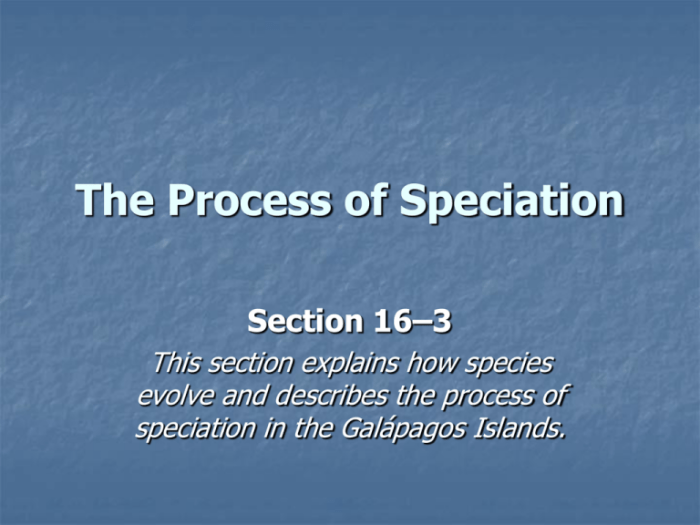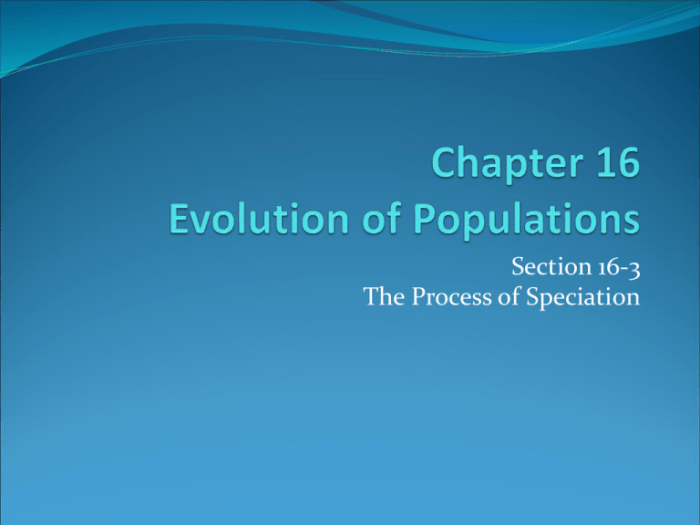Section 16-3 the process of speciation – In the realm of evolution, the process of speciation stands as a pivotal force, driving the diversification of life on Earth. Section 16-3 embarks on an in-depth exploration of this intricate phenomenon, unraveling its mechanisms, stages, and profound implications for biodiversity.
Speciation, the formation of new and distinct species, lies at the heart of evolutionary history. It shapes the tapestry of life, giving rise to a myriad of organisms that inhabit our planet. This section delves into the complexities of speciation, shedding light on the factors that influence its occurrence and the genetic underpinnings that drive it.
The Definition and Significance of Speciation

Speciation is the process by which new species arise from existing ones. It is a fundamental concept in evolutionary biology, as it explains how the diversity of life on Earth has come into being. Speciation can occur through a variety of mechanisms, including geographic isolation, reproductive isolation, and natural selection.
Mechanisms of Speciation
- Geographic isolation: This occurs when two populations of the same species become separated by a physical barrier, such as a mountain range or a body of water. Over time, the two populations may evolve independently, becoming so different that they can no longer interbreed.
- Reproductive isolation: This occurs when two populations of the same species are able to live in the same area but cannot interbreed due to differences in their mating behaviors or reproductive systems.
- Natural selection: This occurs when certain traits give some individuals an advantage in survival and reproduction, allowing them to pass on their genes to future generations. Over time, this can lead to the evolution of new species.
The Stages of the Speciation Process

The process of speciation typically occurs in a series of stages:
Stage 1: Geographic isolation
The first stage of speciation is geographic isolation, which occurs when two populations of the same species become separated by a physical barrier. This can happen due to events such as the formation of a new mountain range, the flooding of a river, or the splitting of a continent.
Stage 2: Reproductive isolation
Once two populations are geographically isolated, they may begin to evolve independently. This can lead to the development of reproductive isolation, which prevents the two populations from interbreeding. Reproductive isolation can be caused by a variety of factors, such as differences in mating behaviors, the development of new mating structures, or changes in the timing of reproduction.
Stage 3: Speciation
Once two populations have become reproductively isolated, they have become separate species. This means that they can no longer interbreed and produce fertile offspring. The process of speciation is complete.
The Genetic Basis of Speciation: Section 16-3 The Process Of Speciation

The genetic basis of speciation is complex and involves a variety of factors, including genetic drift and natural selection.
Genetic drift
Genetic drift is the random change in the frequency of alleles in a population. It can occur due to a variety of factors, such as the founder effect, the bottleneck effect, and random sampling.
Natural selection
Natural selection is the process by which individuals with certain traits are more likely to survive and reproduce than individuals with other traits. Over time, this can lead to the evolution of new species.
The Impact of Speciation on Biodiversity
Speciation is a major contributor to the diversity of life on Earth. It is responsible for the evolution of all of the different species that exist today, from bacteria to plants to animals.
The role of speciation in the formation of new species and ecosystems
Speciation plays a major role in the formation of new species and ecosystems. When new species evolve, they can fill new ecological niches and create new food webs. This can lead to the development of new ecosystems, which in turn can support even more new species.
Examples of how speciation has influenced the evolution of different groups of organisms, Section 16-3 the process of speciation
Speciation has played a major role in the evolution of all of the different groups of organisms on Earth. For example, the evolution of mammals from reptiles was a result of speciation. The evolution of birds from dinosaurs was also a result of speciation.
The Applications of Speciation Research

Speciation research has a wide range of applications, including in the fields of conservation biology and agriculture.
Conservation biology
Speciation research can help us to understand the factors that lead to the formation of new species and the extinction of existing species. This information can be used to develop conservation strategies to protect endangered species and their habitats.
Agriculture
Speciation research can help us to understand the genetic basis of different traits in crops and livestock. This information can be used to develop new breeding techniques to improve the yield and quality of food.
Commonly Asked Questions
What is the significance of speciation in evolution?
Speciation is the driving force behind the diversification of life on Earth. It leads to the formation of new species, increasing the complexity and richness of ecosystems.
How does geographic isolation contribute to speciation?
Geographic isolation physically separates populations, reducing gene flow and allowing for the accumulation of genetic differences. Over time, these differences can become so significant that the populations become reproductively isolated and evolve into distinct species.
What role does natural selection play in speciation?
Natural selection acts on genetic variation within populations. In isolated populations, different selective pressures can lead to the accumulation of different traits, contributing to the genetic divergence that ultimately leads to speciation.